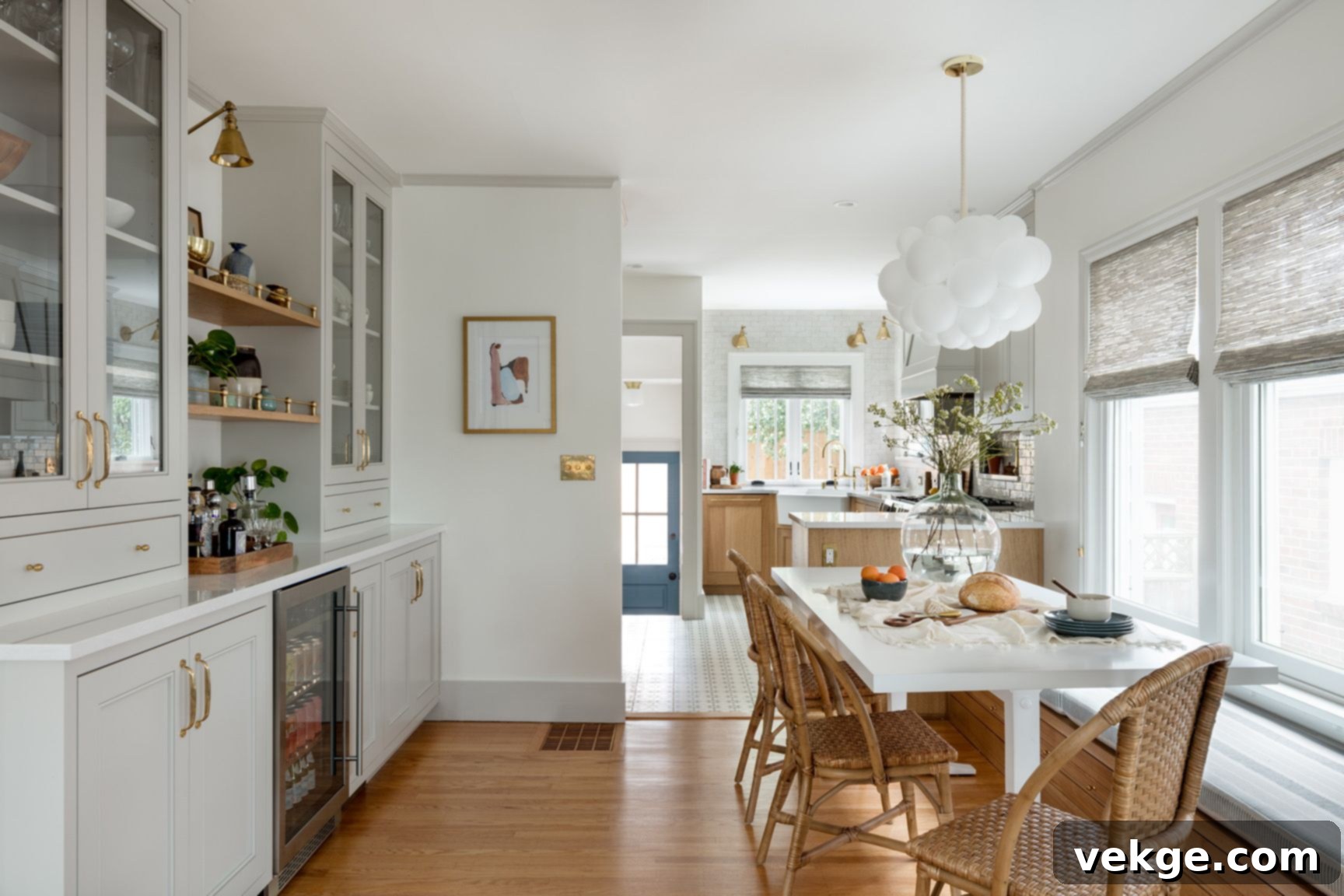Ultimate Guide to Butler’s Pantry Cabinets: Design, Style, and Functionality
In modern homes, the butler’s pantry has evolved from a historical utility space into a coveted extension of the kitchen, offering unparalleled functionality and elegant storage. At the heart of a well-designed butler’s pantry are its cabinets, which serve as much more than just storage units; they are pivotal in defining the space’s aesthetic and operational efficiency. Choosing the right design, style, and materials that are both eye-pleasing and supremely functional can seem like a daunting task. However, the reward of a beautifully organized and stylish butler’s pantry, capable of supporting all your culinary and entertaining needs, makes the effort worthwhile. These cabinets are truly stylish and functional additions that elevate any home.
A thoughtfully planned butler’s pantry, with its dedicated cabinetry, provides invaluable extra space to neatly store everything from seldom-used serving dishes and fine china to everyday pantry staples and small kitchen appliances. This dedicated area dramatically reduces clutter in your main kitchen, allowing it to remain pristine and ready for daily use or entertaining. Understanding the myriad of design possibilities and practical considerations is key to unlocking the full potential of this unique space. This comprehensive guide will walk you through all the details, from essential functions to the most elegant design choices, ensuring your butler’s pantry cabinets are perfectly tailored to your lifestyle and home décor.
Why Do We Need Butler’s Pantry Cabinets? Enhancing Home Efficiency and Elegance
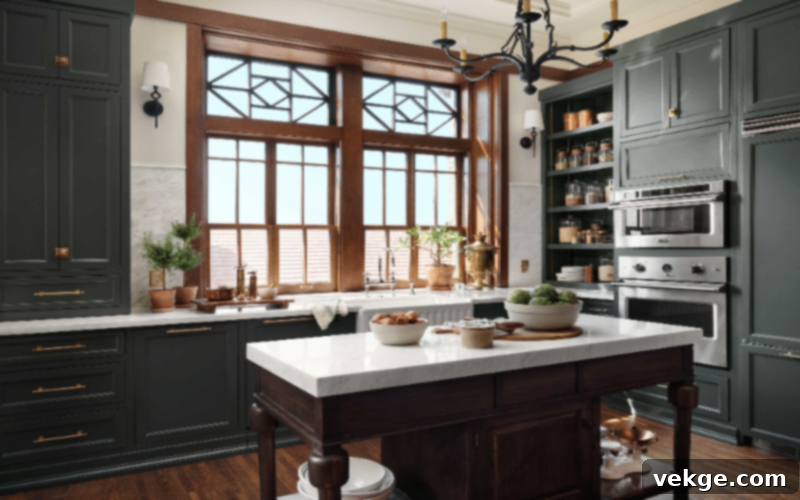
Butler’s pantry cabinets serve as an invaluable asset in modern homes for a multitude of reasons, greatly enhancing both practical utility and sophisticated living. As our lives become increasingly fast-paced and our homes grow into multi-functional hubs, having a dedicated space for meal preparation, meticulous storage, and elegant serving can significantly streamline daily routines and elevate special occasions. Here’s a deeper look into why these cabinets are indispensable:
- Enhanced Storage & Organization: The primary benefit is the ample storage they offer. Butler’s pantry cabinets allow you to neatly organize a vast array of items, from rarely used holiday dishes, delicate glassware, and essential utensils to bulk pantry ingredients and small kitchen appliances. This reduces clutter in the main kitchen, keeping it looking tidy and spacious.
- Dedicated Prep Zone: A butler’s pantry provides an ideal, semi-secluded location for prepping meals, mixing drinks, or packing lunches without disrupting the flow of the primary cooking space. This is particularly advantageous when hosting gatherings, as it allows hosts to prepare and stage food and beverages in an organized manner, keeping the inevitable mess out of sight from guests.
- Entertaining & Serving Hub: For those who love to entertain, the butler’s pantry transforms into a crucial staging area. It can house an additional sink, a mini-fridge for drinks, or even a warming drawer, facilitating seamless serving. Guests can help themselves to drinks or appetizers without venturing into the main kitchen, maintaining an elegant atmosphere.
- Increased Home Value: A well-designed and functional butler’s pantry is a highly sought-after feature in today’s real estate market. It’s often viewed as a luxury amenity that adds significant appeal and value to a home, appealing to buyers who appreciate both aesthetics and practicality.
- Noise & Odor Containment: Placing noisy appliances like blenders or coffee makers in the pantry, along with containing certain cooking odors, can contribute to a more serene and pleasant main kitchen environment.
In essence, butler’s pantry cabinets aren’t just about storage; they’re about creating a more organized, efficient, and enjoyable home environment.
Cabinet Design Styles: Crafting the Perfect Aesthetic for Your Butler’s Pantry
The aesthetic appeal of your butler’s pantry largely hinges on the cabinet design styles you choose. With countless options available, finding the perfect match for your home’s overall decor and your personal taste is key. We’ve shortlisted five elegant and popular styles that can uplift your kitchen’s aesthetics and bring character to your pantry space.
1. Traditional Style
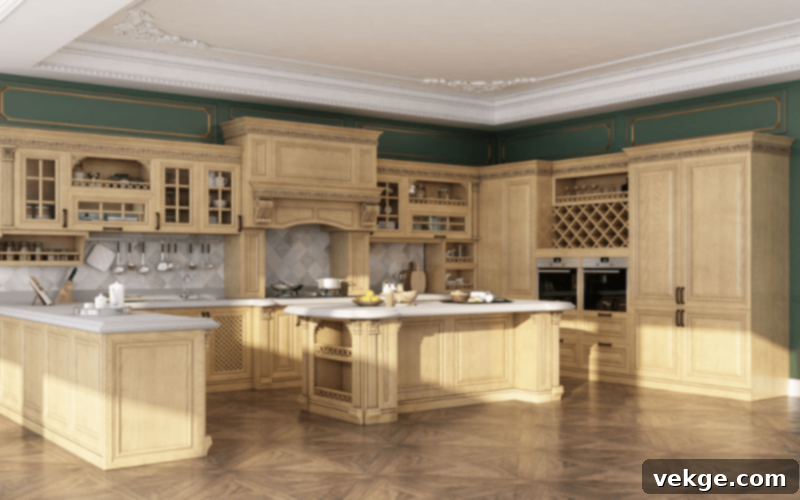
The traditional style exudes timeless elegance and classic sophistication. It often features raised panel doors with intricate detailing, decorative molding, and ornate hardware such as bronze or polished brass handles. Materials like rich hardwoods (cherry, maple, oak) are common, often with stained finishes that highlight the natural grain. If your home boasts a classic or heritage design, traditional cabinets can seamlessly blend in, creating a sense of luxury and established comfort. This enduring style remains popular among design enthusiasts who appreciate the warm, inviting appeal often associated with countryside and farmhouse kitchen decors, but with an added touch of refined grandeur.
2. Modern and Minimalist
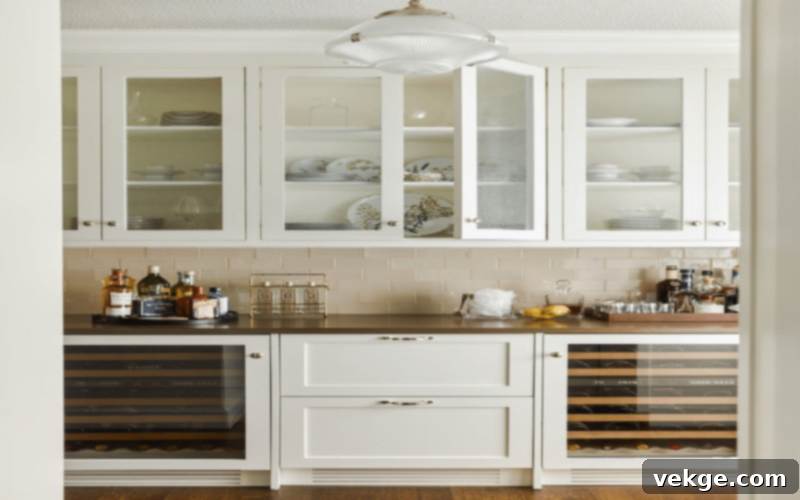
For a clean, sleek, and uncluttered look, opt for modern and minimalist cabinet designs. These cabinets are characterized by flat panel doors (slab doors), simple or integrated hardware, and a strong focus on functionality. The aesthetic is often defined by clean lines, geometric shapes, and a lack of ornamentation, emphasizing open space and light. This style works exceptionally well in contemporary homes with a minimalist aesthetic, where functionality and efficiency are paramount. Common finishes include high-gloss or matte lacquers, veneers, and laminates in neutral or monochromatic color schemes, creating a sophisticated and simple yet highly functional space.
3. Rustic and Farmhouse
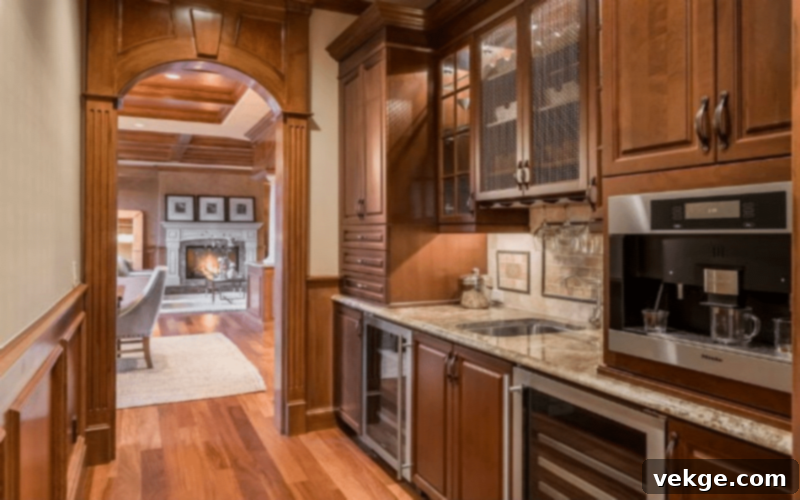
If you’re drawn to a cozy, inviting, and down-to-earth vibe, rustic or farmhouse cabinets might be your ideal choice. These cabinets often showcase natural wood with distressed finishes, emphasizing imperfections and the beauty of raw materials. Features like beadboard paneling, open shelving, and a mix of materials such as reclaimed wood, natural stone, and metal hardware are characteristic. They are perfect for creating a warm, charming, and welcoming atmosphere reminiscent of a country home, offering a comfortable backdrop for both preparation and display. Distressed paints in soft, muted tones are also common, adding to their lived-in appeal.
4. Contemporary Style (Transitional)
Often referred to as transitional, the contemporary style offers the best of both worlds by blending elements of traditional elegance with modern simplicity. These cabinets feature clean lines but might include subtle decorative elements, such as a slightly raised panel or a muted color palette. The hardware is typically understated, bridging the gap between ornate and minimalist. This versatility makes contemporary cabinets suitable for a wide range of home styles, appealing to those who appreciate a balanced aesthetic that feels fresh yet enduring. They offer a refined look that avoids extremes, focusing on comfort, functionality, and timeless design that can adapt to evolving trends.
5. Glass-Front Cabinets
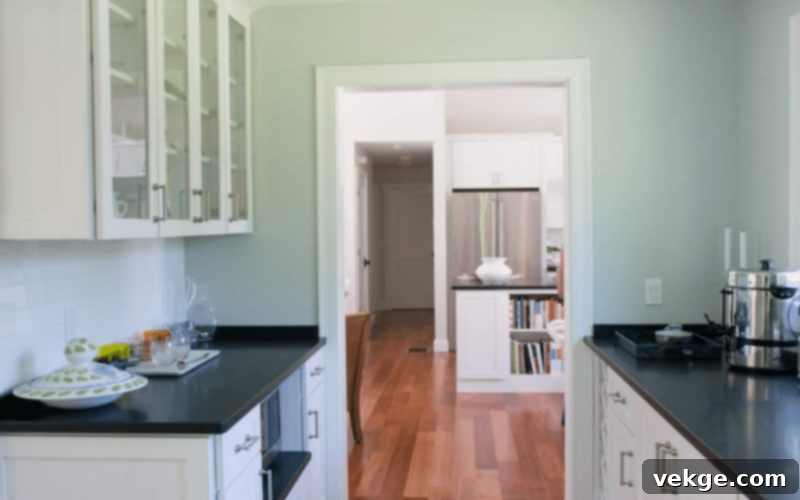
Glass-front cabinets are a versatile feature that can be integrated into nearly any design style, from traditional to modern. They add an element of openness and lightness to the pantry, allowing you to beautifully display your curated collection of dishes, glassware, and decorative items. These cabinets are perfect for showcasing your prized possessions while keeping them protected and easily accessible. Various types of glass can be used, including clear for full visibility, frosted for a hint of mystery, or seeded glass for a vintage touch. When combined with interior lighting, glass-front cabinets can create a stunning focal point, adding visual depth and character to your butler’s pantry.
Choosing Cabinet Materials: Durability Meets Design in Your Butler’s Pantry
The material you select for your butler’s pantry cabinets is crucial, as it significantly impacts their durability, aesthetic appeal, and long-term maintenance. Each material offers distinct advantages and contributes to the overall look and feel of your pantry. Common materials include:
1. Wood
Wood remains a classic and highly durable choice for cabinet construction, prized for its natural beauty and resilience. Hardwoods like oak, maple, cherry, and walnut are popular due to their inherent strength, longevity, and distinct grain patterns. Oak offers a pronounced grain, maple provides a smoother, finer texture, cherry darkens beautifully with age, and walnut boasts rich, deep tones. Wood cabinets can be stained to enhance their natural color, painted for a custom look, or left with a clear finish. While solid wood can be a more significant investment, it offers timeless appeal and excellent durability. For a more budget-friendly option, consider plywood with a high-quality veneer finish, which offers many of the aesthetic benefits of solid wood at a lower cost.
2. MDF (Medium-Density Fiberboard)
MDF is an engineered wood product made from wood fibers, wax, and resin, pressed into dense panels. It offers an exceptionally smooth surface, making it an excellent choice for painted or high-gloss finishes where a flawless look is desired. MDF is a cost-effective alternative to solid wood, and its uniform composition makes it less prone to expansion and contraction due to humidity changes, which can lead to cracking in paint finishes on solid wood. However, MDF is not as moisture-resistant as solid wood and can swell if exposed to excessive water, making proper sealing and careful placement important.
3. Laminate
Laminate cabinets are constructed by layering a thin, decorative material (often plastic, paper, or foil impregnated with resin) onto a composite board, such as MDF or particle board. They come in an incredibly wide variety of colors, patterns, and textures, including realistic wood grains and stone finishes, offering immense design flexibility. Laminate is known for its durability, resistance to scratches and stains, and ease of cleaning, making it a highly practical and budget-friendly option. Modern laminates have significantly improved in quality and appearance, offering a contemporary and sleek look that is both attractive and low-maintenance.
4. Metal
Metal cabinets, particularly those made from stainless steel, can provide a distinctive industrial and modern look. Stainless steel cabinets are highly popular for their sleek appearance, exceptional durability, hygienic properties, and resistance to heat and moisture. They are often found in professional kitchens and are increasingly making their way into residential spaces for their robust performance and minimalist aesthetic. While they offer unparalleled longevity and a striking appearance, metal cabinets might be pricier than other options and can show fingerprints or smudges more readily, requiring regular cleaning to maintain their pristine look. Other metals, like powder-coated steel, can offer color options with a similar modern edge.
Popular Color Palettes for Butler’s Pantry Cabinets: Setting the Mood
Just as in any living space, colors play a major role in uplifting the look and feel of your butler’s pantry. To truly style your butler’s pantry cabinets, you need to select colors that harmonize with your main kitchen and overall home aesthetic, creating a cohesive and inviting environment.
1. Neutral Colors
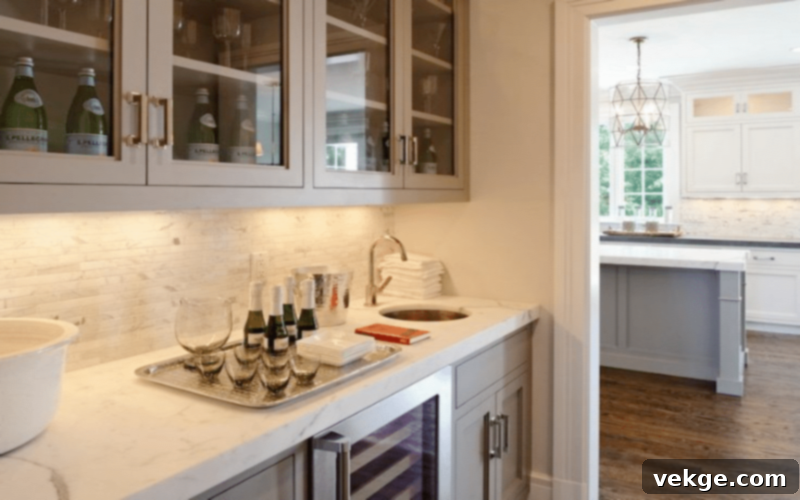
Neutral colors such as crisp white, warm cream, soft beige, and sophisticated gray are timeless and incredibly versatile choices for butler’s pantry cabinets. They create a sense of spaciousness, brightness, and serenity, making the pantry feel larger and more inviting. These colors serve as a perfect backdrop, allowing you to easily change other decor elements or accessories over time without clashing. Neutrals are consistently in trend and work exceptionally well across various design styles, from sleek contemporary kitchens to charming farmhouse decors, providing an understated elegance that never goes out of style.
2. Bold Colors
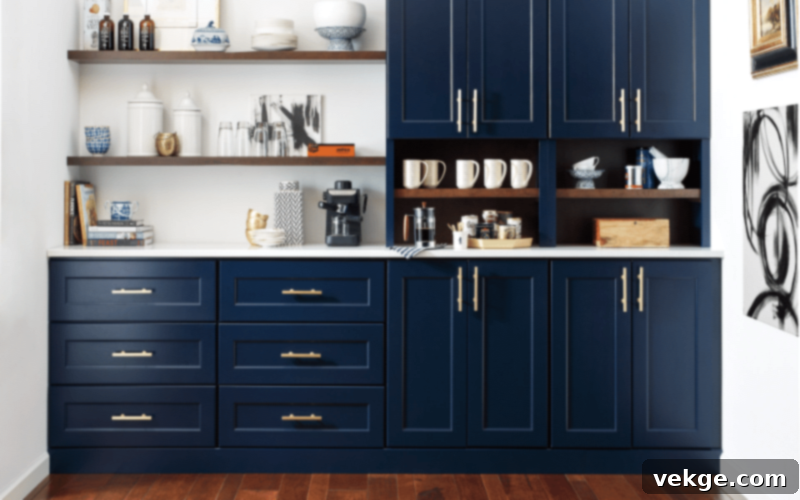
If you’re feeling adventurous and want to make a statement, consider incorporating bolder colors like deep navy blue, vibrant forest green, dramatic charcoal, or even sophisticated black for your pantry cabinets. These colors can add a dramatic flair and undeniable personality to the space, transforming it into a stylish focal point. Bold colors look particularly elegant when thoughtfully paired with complementary neutral elements or contrasting metallics. When designing with bold colors, it’s essential to choose wisely and use the color palette intentionally to ensure it enhances the overall aesthetic and doesn’t overwhelm the space. They can create a luxurious and unforgettable impression.
3. Stained Woods

For those who opt for wooden cabinets, a stained finish is an excellent way to highlight and celebrate the natural beauty of the wood grain. Stains come in a wide spectrum, from light, airy tones that preserve the wood’s original character to rich, dark hues that add depth and formality. Choosing a stained finish can introduce warmth, texture, and a timeless appeal to your butler’s pantry. It’s crucial to select a stain that complements the existing wood tones in your main kitchen or other connecting spaces, ensuring a cohesive and harmonious flow. Stained wood cabinets offer an authentic and inviting feel that pairs beautifully with various design styles, from rustic to traditional.
4. Two-Tone Designs
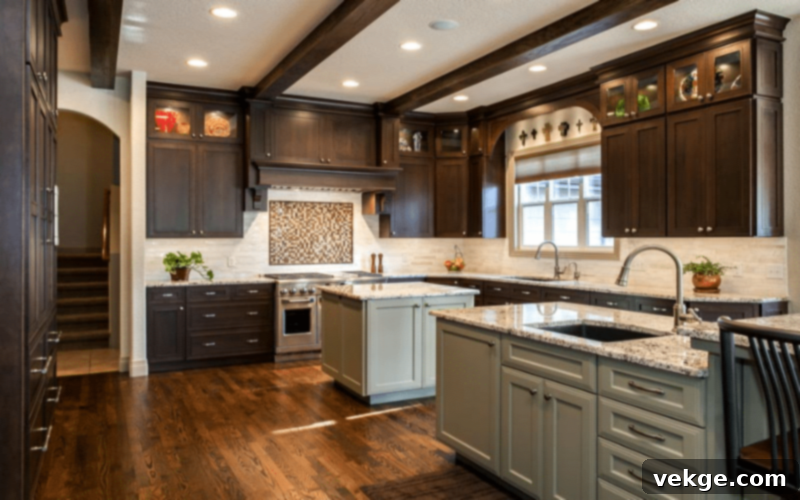
Mixing different cabinet colors or finishes within your butler’s pantry is a highly effective way to create visual interest, define different zones, and add depth to the space. This two-tone design can create an amazing and dynamic effect, offering distinct perspectives. For instance, you might choose lighter-colored upper cabinets to create an airy feel and make the space appear taller, paired with darker lower cabinets to ground the design and hide scuffs. Popular combinations include white or light gray uppers with navy or charcoal lowers, or stained wood lowers with painted uppers. This approach allows for a personalized and sophisticated look that breaks the monotony of a single color while enhancing the overall aesthetic of the pantry.
Planning Your Butler’s Pantry: Key Considerations for a Functional Space
Beyond style and color, a truly effective butler’s pantry requires careful planning of its layout and internal features. Thinking through these practical elements will ensure your pantry is not only beautiful but also highly efficient.
Layout & Size
The layout of your butler’s pantry will largely depend on the available space and your specific needs. Common layouts include a simple walk-through corridor, a more spacious galley style with cabinets on two opposing walls, or an L-shaped design. Consider the minimum clearance needed for comfortable movement, especially if multiple people will be using the space simultaneously. If space allows, integrating a small countertop section is invaluable for food prep or appliance use.
Lighting
Proper lighting is essential for both functionality and ambiance. Incorporate task lighting under upper cabinets to illuminate countertops, and ambient lighting (like recessed lights or a stylish pendant) for overall brightness. If you have glass-front cabinets, consider interior lighting to showcase their contents and add an inviting glow.
Countertops
The choice of countertop material should prioritize durability and ease of cleaning, as this surface will likely see a lot of activity. Quartz and granite are excellent choices for their resilience and aesthetic appeal. Butcher block can add warmth and is great for food prep, while laminate offers a budget-friendly and practical option. Ensure the countertop is resistant to stains, heat, and scratches.
Sinks & Appliances
Depending on your needs, a small utility sink in the butler’s pantry can be incredibly useful for quick clean-ups or filling pitchers. Many homeowners also choose to house small appliances like coffee makers, toasters, or even a mini-fridge in this space, freeing up valuable counter space in the main kitchen. Plan for appropriate electrical outlets to support these appliances.
Maximizing Functionality with Smart Storage Solutions
A butler’s pantry’s true power lies in its ability to keep things organized and accessible. Incorporating smart storage solutions into your cabinet design can transform the space from merely functional to exceptionally efficient.
Pull-Out Shelves & Drawers
Eliminate digging around in deep cabinets with pull-out shelves or drawers. These features bring the contents of your cabinets to you, making it easy to access pots, pans, small appliances, or pantry staples. Full-extension glides ensure everything is within reach.
Spice Racks & Pantry Organizers
Dedicated spice racks (either door-mounted or drawer inserts) keep your spices organized and visible. Adjustable shelving, specialized bins for produce, and tiered organizers for cans can make the most of vertical space and prevent items from getting lost.
Wine Racks & Bar Storage
If entertaining is a priority, consider integrating wine racks, liquor storage, and glassware display areas. This keeps your bar essentials conveniently located in the pantry, ready for your next gathering.
Appliance Garages
For a truly clean and uncluttered look, an appliance garage with a retractable or lift-up door can neatly conceal small appliances like blenders or stand mixers when not in use, keeping countertops clear.
Open Shelving
While closed cabinets are great for hiding clutter, strategically placed open shelving can be beautiful for displaying curated collections of cookbooks, decorative dishes, or fresh herbs, adding personality and accessibility to your pantry.
Conclusion
Choosing the right design and style for your butler’s pantry cabinets is a journey that requires thoughtful consideration of your family’s needs, your home’s overarching aesthetics, and your personal preferences. Remember to strike a harmonious balance between functionality and visual appeal to create a space that is both practical for daily use and wonderfully inviting for special occasions. From the choice of cabinet style and durable materials to the careful selection of color palettes and smart storage solutions, every decision contributes to the overall success of this often-underestimated space.
Whether you opt for the classic elegance of traditional designs, the streamlined simplicity of modern cabinets, the cozy charm of rustic styles, or a unique, personalized combination, your butler’s pantry cabinets will play a vital role in shaping a highly organized, efficient, and beautiful extension of your kitchen. A well-designed butler’s pantry not only enhances your culinary workflow and entertaining capabilities but also adds significant value and sophisticated convenience to the heart of your home.
